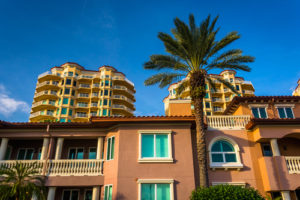Does the association’s insurance cover hurricane damages to building exteriors?

The HOA’s insurance must provide coverage to repair or replace all portions of the condominiums property as originally installed or replace the destroyed property with something of like kind and quality. -St. Petersburg Florida Condo Towers
Since Hurricane Irma, we have received a number of questions regarding homeowners insurance and what is covered. We thought this week we would look at the question of who pays for damage to the outside of a condominium building and whose insurance covers any damage done to the interior of a unit.
This issue came up during the aftermath of Hurricane Wilma back in 2005 as condominium associations made claims under their property insurance policies while homeowners submitted claims on their homeowners insurance policies for the same issues.
This resulted in a slew of denied claims as the HOA’s insurance company claimed the homeowner was responsible while the homeowners insurance company claimed that the HOA was responsible. The Florida legislature got involved and passed the Florida Condominium Act, which was designed to provide clarity in regards to who was responsible in the event of storm damage.
What the Florida Condominium Act Says
The Florida Condominium Act states that an HOA must provide adequate property insurance to cover the repair or replacement cost of the insured property as determined by an independent appraisal, which must be done every 36 months. The HOA must also take into account the deductible when determining the proper amount of insurance to carry.
The HOA’s insurance must provide coverage to repair or replace all portions of the condominiums property as originally installed or replace the destroyed property with something of like kind and quality. In insurance industry lingo “condominium property” refers to all property that is not included within the confines of an individual unit, up to the horizontal and vertical concrete slabs.
Basically this means that any damage to the outside of the building, including landscaping such as trees and shrubs should be handled by the HOA’s insurance policy. If all the damage to your condo is on the outside, there is no need for you to file a claim with your homeowners insurance company.
On the other hand, if the damage is within the walls of your particular unit, your homeowners insurance will have to address the issue and pay out the claim. According to the Florida Condominium Act, the associations property insurance must specifically excluded all personal property within a unit including wall and ceiling coverings, appliances, water heaters, electrical fixtures, window treatments, countertops and blinds. While this is only a partial list, the basic idea is that anything within the walls of your unit, falls to your homeowners insurance.
The HOA Must Replace Covered Property
Unless a majority of voting interests in the association approve, the HOA must repair or replace any damaged covered by their insurance policy, including the deductible. Any damage that exceeds the policy limits is considered a common expense that must be paid proportionately by all owners in the building.
This means that the HOA must repair the building to its original standards unless a majority of homeowners vote to not repair or replace the damage. As an example, if a pool house that is no longer used was destroyed and the majority of unit owners vote to not replace it, the HOA would simply not make a claim to repair or replace it.
Once the policy limits of the HOA policy are reached, all excessive damage must be split evenly and paid amongst the condo owners.
Get Solid Advice
While the Florida Condominium Act is pretty clear on who needs to provide coverage, experts recommend that all HOAs consult with a legal and insurance expert in regards to their obligations and proper coverage levels. This should be done before the need arises and they discover they are not fully insured.
Once a claim needs to be made, experts recommend getting expert legal and insurance advice as well as retaining a building industry professional who can help with assessing the damage and calculate the true cost to repair or replace the damaged areas.
Condo owners, and anyone shopping for a condo should verify that their association is carrying the proper amount of coverage and that any damage that occurs outside of their unit will be repaired. The same holds true for your personal insurance, consult with an expert to make sure you are properly covered in the event the interior of your unit is damaged.
A Few Claim Tips
If you do end having to make a claim on your personal homeowner policy, here are a few tips to consider:
Document Your Loss: As soon as it is safe, document your losses with photos and videos. Take photos from a variety of angles and video of all of the damage, before you make any temporary repairs. Make a list of the all lost or destroyed property as well.
Keep Detailed Records: Keep detailed records of the entire claim process. Make notes after every interaction with your insurance company, including the name and title of whom you spoke with and an overview of your conversation. Also keep detailed records of any expenses you incur related to temporarily repairing your home as well as expenses such as hotels and restaurants if you cannot live in your home.
Do Not Discard Anything: Before throwing away damaged items, check with your insurance company to make sure it is ok to get rid of it. They may require their adjuster to see it in person before you can discard it. Always take a photo of anything you are going to throw away before discarding it.
Embrace Technology: Most insurance companies allow you to start a claim online as well as receive text alerts regarding the status of your claim. Going high tech makes the entire process easier.
